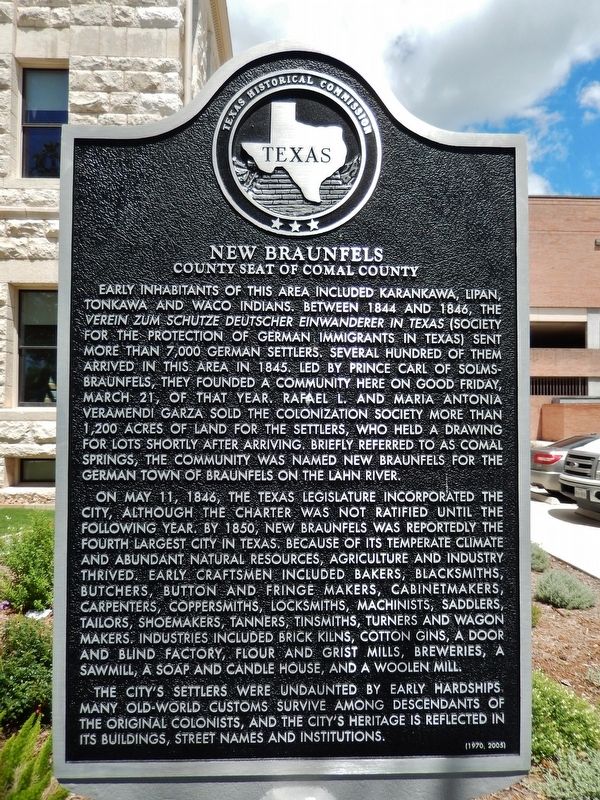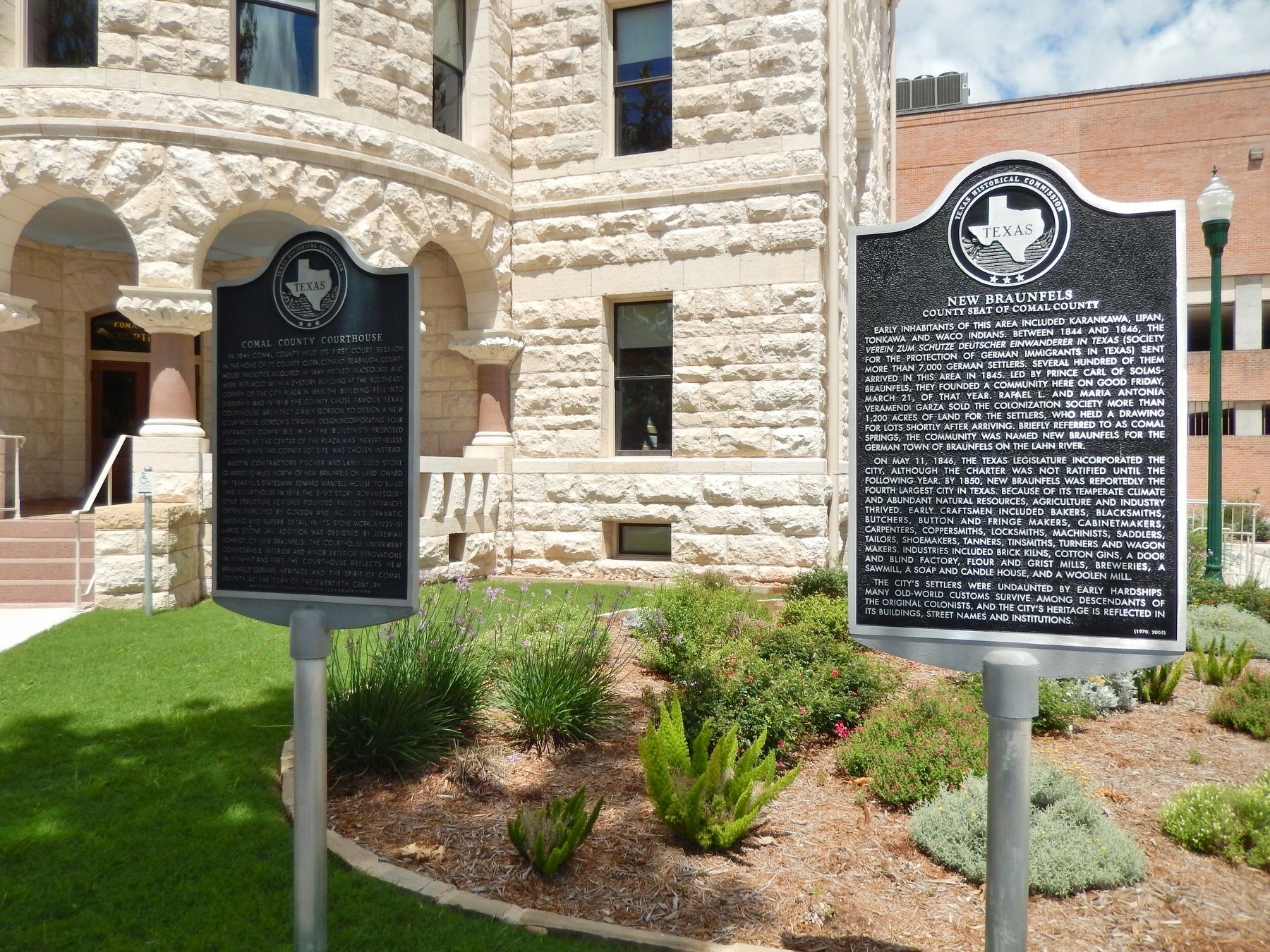New Braunfels in Comal County, Texas — The American South (West South Central)
New Braunfels
County Seat of Comal County
Early inhabitants of this area included Karankawa, Lipan, Tonkawa and Waco Indians. Between 1844 and 1846, the Verein Zum Schutze Deutscher Einwanderer in Texas (Society for the protection of German immigrants in Texas) sent more than 7,000 German settlers. Several hundred of them arrived in this area in 1845. Led by Prince Carl of Solms-Braunfels, they founded a community here on Good Friday, March 21, of that year. Rafael L. and Maria Antonia Veramendi Garza sold the colonization society more than 1,200 acres of land for the settlers, who held a drawing for lots shortly after arriving. Briefly referred to as Comal Springs, the community was named New Braunfels for the German town of Braunfels on the Lahn River.
On May 11, 1846, the Texas Legislature incorporated the city, although the charter was not ratified until the following year. By 1850, New Braunfels was reportedly the fourth largest city in Texas. Because of its temperate climate and abundant natural resources, agriculture and industry thrived. Early craftsmen included bakers, blacksmiths, butchers, button and fringe makers, cabinetmakers, carpenters, coppersmiths, locksmiths, machinists, saddlers, tailors, shoemakers, tanners, tinsmiths, turners and wagon makers. Industries include brick kilns, cotton gins, a door and blind factory, flour and grist mills, breweries, a sawmill, a soap and candle house and a woolen mill.
The City’s settlers were undaunted by early hardships. Many old-world customs survive among descendants of the original colonists, and the city’s heritage is reflected in its buildings, street names and institutions.
Erected 1970 by Texas Historical Commission. (Marker Number 3574.)
Topics. This historical marker is listed in these topic lists: Industry & Commerce • Settlements & Settlers.
Location. 29° 42.216′ N, 98° 7.483′ W. Marker is in New Braunfels, Texas, in Comal County. Marker is at the intersection of East San Antonio Street and North Seguin Avenue, on the right when traveling west on East San Antonio Street. Marker is located at the northeast corner of the Comal County Courthouse, between the parking lot and the east entrance. Touch for map. Marker is at or near this postal address: 100 North Seguin Avenue, New Braunfels TX 78130, United States of America. Touch for directions.
Other nearby markers. At least 8 other markers are within walking distance of this marker. Comal County Courthouse (here, next to this marker); Comal County World War I Monument (within shouting distance of this marker); Comal County, C.S.A. (within shouting distance of this marker); Main Plaza Bandstand (about 300 feet away, measured
in a direct line); Site of Old Schmitz Hotel (about 300 feet away); Eiband and Fischer General Mercantile (about 300 feet away); August Dietz Cottage (about 400 feet away); Stephen Klein Home (about 500 feet away). Touch for a list and map of all markers in New Braunfels.
Regarding New Braunfels. Several Native American tribes inhabited this area because of the fresh spring water available. The expedition of Domingo Terán de los Ríos of 1691, followed the “El Camino Real” (today a National Historic Trail), which crossed the Guadalupe River near today’s Faust Street Bridge. Subsequent French and Spanish expeditions, including those of the Marqués de Aguayo and Louis Juchereau de St. Denis, commonly passed through this area.
An 1825, a Mexican land grant gave title of the area around the springs to Juan M. Veramendi. During the eighteenth century, the springs and river (which had been called Las Fontanas and the Little Guadalupe respectively) took the name Comal, Spanish for "flat dish," and Guadalupe.
Also see . . . New Braunfels, TX. Texas State Historical Association:
Taking advantage of the reliable water power afforded by Comal Springs and the community's position on the road between Austin and San Antonio, the settlers wasted little time establishing the supply and processing businesses-stores, millworks, and craft shops-that soon made New Braunfels the commercial center of a growing agricultural area. By the early 1880s, with a population estimated at 2,000, the community was linked by telegraph and rail lines with Austin and San Antonio, and textile factories along the Comal River were shipping cotton and woolen products. The following decade saw the installation of electric streetlights and the first telephone line through New Braunfels.
(submitted on December 9, 2017, by Cosmos Mariner of Cape Canaveral, Florida) (Submitted on January 31, 2021.)
Credits. This page was last revised on January 31, 2021. It was originally submitted on December 9, 2017, by Cosmos Mariner of Cape Canaveral, Florida. This page has been viewed 592 times since then and 62 times this year. Photos: 1, 2. submitted on December 9, 2017, by Cosmos Mariner of Cape Canaveral, Florida. • Bernard Fisher was the editor who published this page.

